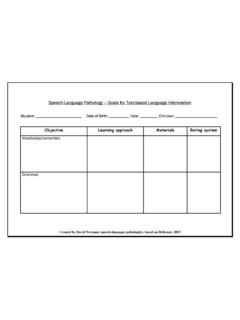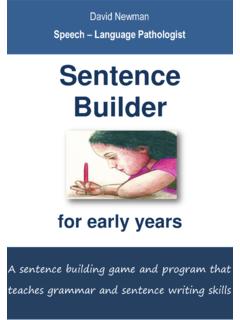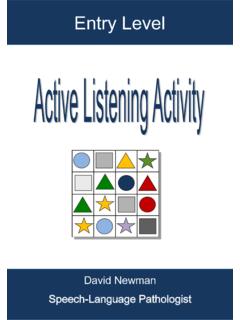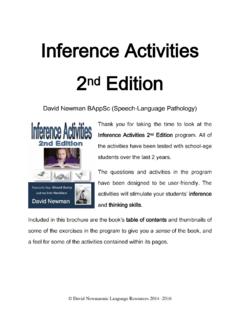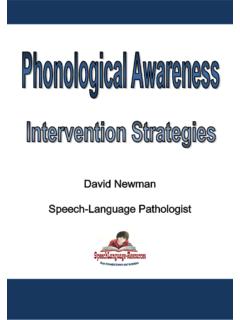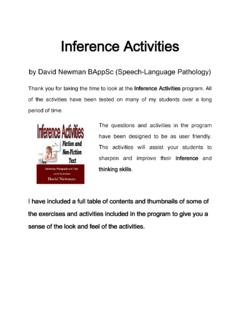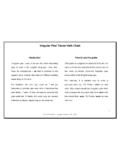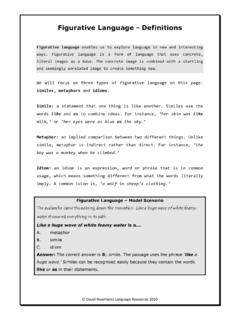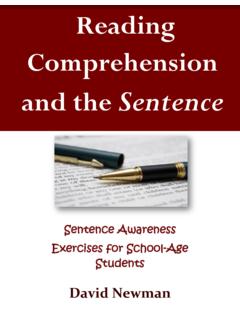Transcription of David Newman Speech-Language Pathologist
1 David Newman Speech-Language Pathologist Sounds to Graphemes Guide D a v i d N e w m a n S p e e c h- l a n g u a g e p a t h o l o g i s t David Newman Speech-Language Pathologist A Friendly Reminder David Newmonic language Resources 2015 - 2018 This program and all its contents are intellectual property. No part of this publication may be stored in a retrieval system, transmitted or reproduced in any way, including but not limited to digital copying and printing without the prior agreement and written permission of the author. However, I do give permission for class teachers or Speech-Language pathologists to print and copy individual worksheets for student use. Table of Contents Sounds to Graphemes Guide - Introduction .. 1 Sounds to Grapheme Guide - Meanings .. 2 Pre-Test Assessment .. 6 Reading Miscue Analysis Symbols .. 8 Intervention Ideas .. 10 Reading Intervention Example .. 12 44 Phonemes Charts .. 18 Consonant Sound Charts and Sound Stimulation.
2 22 Vowel Sound Charts .. 49 Consonant Sounds to Grapheme Charts .. 55 Vowel Sounds to Grapheme Charts .. 60 Rating Progress .. 65 Rating Progress Form .. 66 References .. 67 Appendix A .. 69 Appendix B .. 72 Words Used in Sounds to Graphemes 75 Introduction 1 Sounds to Graphemes Guide - Introduction Phonics based reading programs are evidence based methods of teaching people to read by matching speech sounds with letters or groups of letters known as graphemes. This guide is designed to be used as a visual aid and as a handy and accessible reference to help students match speech sounds with the corresponding graphemes. This skill becomes important when students are confronted with a word that is difficult to sound out or does not follow conventional spelling rules. For instance, the word tough contains three phonemes and five letters. If a word such as tough was to be spelt conventionally in the absence of grapheme rules it might resemble tuff. The five letters in the word tough are represented by three graphemes.
3 The graphemes are t ou gh. The initial t is simple enough for younger readers to recognise. The same is not true of the grapheme ou or the final grapheme gh. Both graphemes require more in depth knowledge of spelling rules and patterns to understand that ou represents the /u/ phoneme and gh represents the /f/ phoneme. This guide s primary aim is to assist students to efficiently make an informed guesstimate as to what a particular troublesome grapheme represents or which grapheme to select when writing a difficult word. Structure of the Sounds to Graphemes Guide Reference list of terms that range from the meaning of graphemes, vowels and consonants to the respiratory system which generates speech sounds. Pre-test assessment: Instructions and forms to establish a baseline for intervention. Intervention Ideas: Explanation of direct instruction and an example of how to use the guide to identify graphemes in a target word. 44 consonant and vowel charts.
4 Sound stimulation sheets for consonants and sound stimulation techniques. Vowel sound reference charts, vowel curve illustration and vowel charts. Consonant to grapheme charts 1-4 Vowel to grapheme charts 1-4 2 Sounds to Graphemes Guide - Reference Phonemes: phonemes are the smallest unit of speech sound. Phonemes are individual speech sounds. The word cat is made up of 3 phonemes - /k/ / / /t/ - whereas a word such as phone is made up three phonemes /f/ / / /n/. There are 44 phonemes in the English language ; 24 of the phonemes are consonant sounds, 20 are vowel sounds. Consonants: A consonant is a speech sound that is articulated with complete or partial closure of the vocal tract that modifies the breath stream, using mouth structures such as lips, tongue, teeth and glottis. There are twenty four consonant sounds in English. Many consonant sounds exist as sound partners. For instance, the /s/ phoneme is partnered with the /z/ phoneme. Manner and place of articulation are the same in the /s/ and /z/ sounds but the /s/ is voiceless whereas the /z/ is voiced, which changes the nature of the sound.
5 All vowel sounds are voiced. That is, during the production of vowel sounds the vocal folds in the larynx vibrate. This guide makes the point that to better understand the phoneme/letter link it s important to give thought to how speech sounds are made and how consonants and vowels differ. To illustrate this point let us reflect on the /s/ phoneme. The /s/ sound is constructed from a voiceless thin stream of sound that passes through the mouth and over the tongue. The tongue stays slightly behind the teeth which produces the hissing quality of /s/ as the airstream passes over the tongue and between the slightly opened teeth. The /s/ is represented by the grapheme s and is found in words such as sun, seal and sat. Importantly, the /s/ is also represented by the graphemes c as in lace, or ps in psychologist among others. Vowels: a vowel is a speech sound in spoken language that is pronounced with an open vocal tract. In contrast to consonant sounds, vowels occur without build-up of pressure from the articulators.
6 There are 20 different vowels in English. Every word needs to have at least one vowel sound. There are short vowel sounds such as the ubiquitous a e i o u and long vowel sounds such as found in words like light, see or hawk. 3 Graphemes: a grapheme is a written symbol of a phoneme ( speech sound). The letters in the English alphabet make up the various graphemes that represent the 44 English phonemes. Graphemes can be a single letter, such as the letter t that represents the /t/ phoneme in the word too. But the /t/ phoneme can also be represented by two letter graphemes such as tt in pretty or the three letter graphemes ght in light. As we can see by this simple example, graphemes can be confusing to young readers due to the sometimes many different graphemes that can be used to represent the same phoneme. For instance, the /i/ vowel has multiple graphemes, the words see, teach, alley and people all feature the /i/ vowel but have different graphemes (spellings) to represent /i/.
7 Digraph: a digraph, as the name implies, is a grapheme that has two letters that represent a single phoneme. For instance, the two letter grapheme sh is the symbol for the / / phoneme and the ch grapheme represents the /t / phoneme. Split Digraph: the letter e at the end of some words works in harmony with a vowel grapheme to make a particular sound. The split digraph also goes by the more familiar term, the magic e. For instance, the word grip has the / / vowel. If we add the magic e to the end of grip we form the word gripe. The short / / vowel has now become the long vowel /a / which changes the word and the sound of the vowel entirely. Blending: Blending is a phonemic awareness skill that involves combining sounds together to form a word. Blending tasks usually begin with two phoneme words and progress through to four phoneme words. For instance, put these sounds to make a word, two phonemes /k/ - /ey/, three phonemes, /d/ - /o/ - /g/, four phonemes (blend) /d/ - /e/ - /s/ - /k/.
8 Segmentation: Segmentation is a deep level phonemic awareness task that requires a child to identify each sound that makes up a word. As with blending tasks, children should begin with two phoneme words and progress through to segmenting four phoneme words. For instance, tell me each sound you hear in cat. The answer is three sounds or three phonemes, /c/ - /a/ - /t/. 4 speech Sound Structures: Before speech sounds can be converted to graphemes they must first be generated from our respiratory system. When learning about speech sounds it is best to start at the beginning. speech sounds rely on the respiratory system to provide the energy and power for speech to occur. The Respiratory System: When we talk about the production of speech sounds, it's best to start with the respiratory system. speech is reliant on the powerful air flow that is supplied via our respiratory system. When we breathe out, the air travels up through the windpipe (oesophagus) and out through a structure in our throats called the larynx.
9 The larynx can change the nature of the sounds coming out of our lungs. When we use the larynx, it vibrates. That is, the larynx works to make the air-stream coming out of our lungs from quiet to loud sounds. The Larynx (vocal folds): The larynx shapes the sound of our voices. The sound, or phonation, is produced by a pair of vocal folds that are situated in the larynx. The primary function of the larynx is to protest the trachea from food aspiration. A secondary function of the larynx is to manipulate pitch and volume of speech sounds. The larynx can change the nature of the sounds coming out of our lungs. When we produce voiced phonemes the larynx vibrates. That is, the larynx works to make the quiet sounds coming out of our lungs into loud sounds. The larynx can do this rapidly. Vocal folds within the larynx can switch from quiet sounds to loud sounds and back again. The larynx does this automatically without our awareness. Articulation: Articulation is the name given to the precise movements of the tongue, palate, velum and lips to create the vowel and consonant sounds that make up the myriad phonemic elements of language .
10 The amazing thing about articulation is that it must work in harmony with the respiratory and phonatory systems. It does this amazingly well. Once the air from our lungs reaches our mouth (oral cavity) we can then make speech sounds. We make speech sounds by using our tongue, teeth and lips to control the air as it passes through the oral cavity. Our lips, tongue and teeth work in harmony to turn the air from 5 our lungs into speech sounds, and, ultimately, spoken words. Consonants are speech sounds that are created by obstructions of the air flow usually a combination of our tongue, teeth, and lips. In contrast, vowels are generally produced with an open vocal tract, with no obstructions. The Velum (soft palate): The velum, also known as the soft palate, is responsible for closing off the nasal passage during important processes such as swallowing and sneezing. It also performs a vital function during speech in that it closes off the nasal passage for most consonant sounds apart from the nasal consonants /m/, /n/ and / /.
